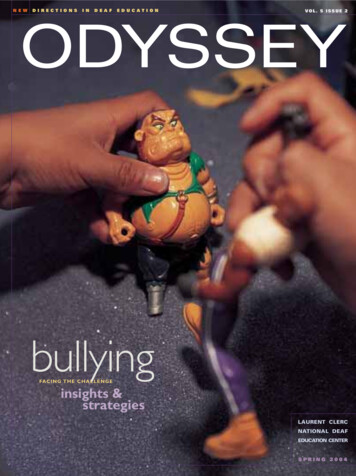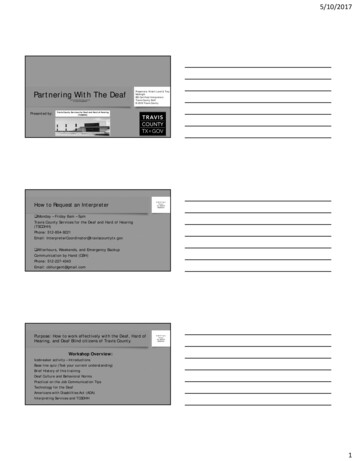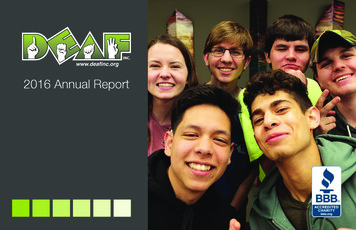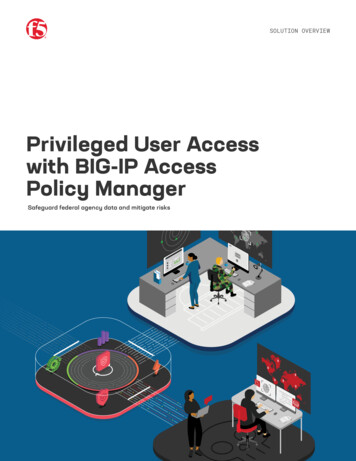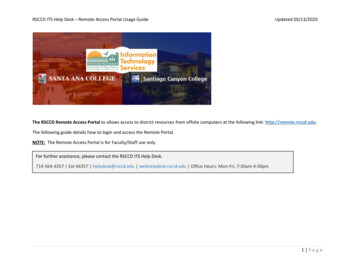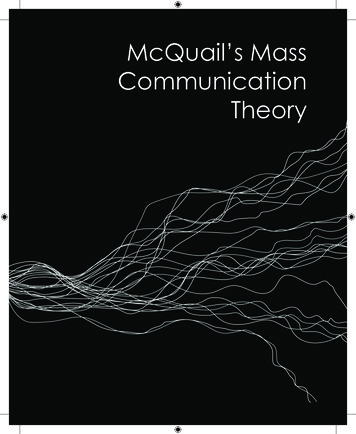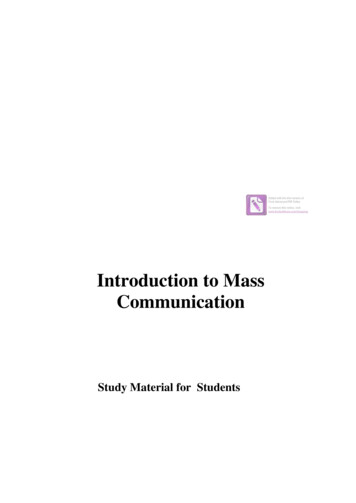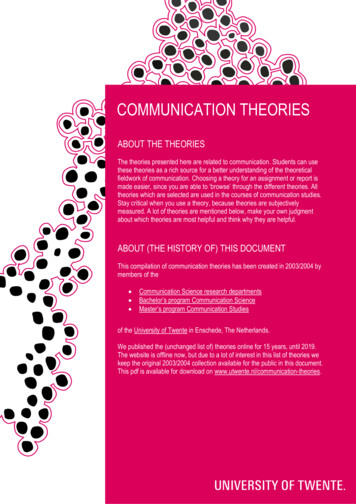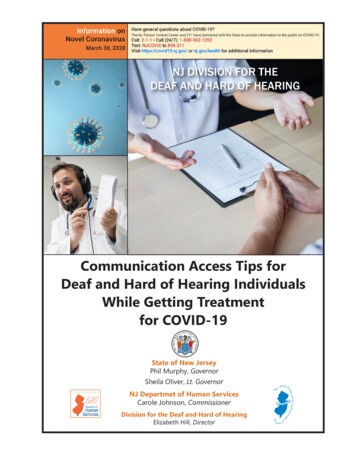
Transcription
NJ DIVISION FOR THEDEAF AND HARD OF HEARINGCommunication Access Tips forDeaf and Hard of Hearing IndividualsWhile Getting Treatmentfor COVID-19State of New JerseyPhil Murphy, GovernorSheila Oliver, Lt. GovernorNJ Departmet of Human ServicesCarole Johnson, CommissionerDivision for the Deaf and Hard of HearingElizabeth Hill, DirectorLorem ipsum
NJ Department of Human ServicesDivision for the Deaf and Hard of HearingCommunication Access Tips for Deaf and Hard of Hearing IndividualsWhile Getting Treatment for COVID-19It is important that deaf and hard of hearing individuals have adequate communication access in healthcare settings during this public health crisis. If you are sick and test positive with COVID-19 and yourdoctor recommends treatment at a hospital, below are some tips to facilitate communication access inthese challenging times.Healthcare professionals are using Personal Protective Equipment (PPE) including masks when caring forpatients during this emergency which may impact communication with individuals who are deaf andhard of hearing. Additionally, some individuals may be placed in isolation units or in field hospitalsfurther impacting communication access. For this reason, DDHH wants to help deaf and hard of hearingindividuals be as prepared as possible.For those who communicate through speaking, lip-reading, and/or listening: The Coronavirus may impact your ability to keep your hearing aids on or your cochlear implanton. Laying down may cause uncomfortable hearing aid feedback or cause the cochlear implant tofall off. Depending on the set-up at the hospital, the healthcare provider may need to communicate withyou via phone from a different room. If you can, bring your smartphone or iPad with you and the chargers that are needed to operatethem. There are certain apps that can be downloaded on your smartphone or iPad assist withcommunication prior to going in for treatment. These apps are listed below. DDHH can work with you on your communication access needs. Bring a notepad and pen for back-up communication or whiteboard, pens, and erasers.Speech to Text Ava (can type back, many languages) (iOS, Android)Google Live Transcribe (can type back, many languages) (Android)Microsoft Translator (can type back, can translate, many languages) (iOS, Android, Windows)Otter.ai (English only) (iOS, Android)Web Captioner (many languages) (universal web-page)Typing Back Big Note (iOS, Android)Cardzilla (iOS, Android)Google Keep (iOS, Android)Sorenson Buzz Cards (iOS, Android)
For phone calls,4 you may want to consider having more than one captioned telephone provider’s appon your phone, in case your provider of choice experiences technical difficulties. CaptionCall (iOS)ClearCaptions (iOS)Hamilton (Android)InnoCaption (iOS, Android)Sprint Web CapTel (universal web-page)Text-based fallback options for phone calls IP Relay (iOS, Android)Mobile TTY or real-time text (RTT) calling 711 (iOS, some Android)4 The FCC currently prohibits the use of VRS when all parties to a call are in the same room. If parties arenot in the same room, VRS is allowed. Patients should comply with all FCC rules.For those who communicate through American Sign Language: If you can, bring your smartphone or iPad with you and the chargers that are needed to operatethem. Smartphones and iPads can be used to access video remote interpreting, video relay services,and other platforms like zoom and facetime that allow for interpreters to assist remotely.Remote Interpreting via different platforms may be used to protect the health of interpreters. Keep in mind that traditional VRI machines may be limited in number or there may berestrictions on use of the equipment in certain parts of the hospital so it is important to haveback-up means of communication in the event that these machines are inaccessible. In some cases, there may be field hospitals such as using convention centers for overflowcapacity. In these cases, your smartphone and paper/pens may be the only means tocommunicate. Video relay service apps may be needed if the healthcare provider needs to communicate viaphone from a different room to reduce risk of exposure. The Coronavirus may impact your ability to keep your hearing aids on or your cochlear implanton. Laying down may cause uncomfortable hearing aid feedback or cause the cochlear implant tofall off. Be sure to download video relay service apps prior to going in for treatment in case you need tocommunicate with a healthcare provider via phone in another room. Use “notes” app to type simple text for communication Contact DDHH for assistance. DDHH can connect you with an interpreter on your smartphoneor iPad via certain platforms like Facetime or Zoom. Bring paper and pen as a back-up if all other communication methods fail even if it is to drawsimple pictures.
Video Interpreting NJ Division of the Deaf and Hard of HearingLinguabee (free video interpreting for COVID-19 testing)Speech to Text Ava (can type back, many languages) (iOS, Android)Google Live Transcribe (can type back, many languages) (Android)Microsoft Translator (can type back, can translate, many languages) (iOS, Android, Windows)Otter.ai (English only) (iOS, Android)Web Captioner (many languages) (universal web page)Typing Back Big Note (iOS, Android)Cardzilla (iOS, Android)Google Keep (iOS, Android)Sorenson Buzz Cards (iOS, Android)For phone calls,3 you may want to consider having more than one video relay service (VRS) provider’sapp on your phone, in case your provider of choice experiences technical difficulties. You also may wantto consider text-based relay services if you can’t get a reliable internet connection. Convo (iOS, Android)Global (iOS, Android)Purple (iOS, Android)Sorenson (iOS, Android)ZVRS (iOS, Android)Text-based fallback options for phone calls IP Relay (iOS, Android)Mobile TTY or real-time text (RTT) calling 711 (iOS, some Android)Some communications applications work by making audio recordings of what speakers are saying andtransmitting them to Internet-based services for translation to text or sign-language. Because therecordings may contain sensitive, private medical information about the patient, patients should bear inmind the potential impacts on their privacy.2The FCC currently prohibits the use of VRS when all parties to a call are in the same room. If parties arenot in the same room, VRS is allowed. Patients should comply with all FCC rules.3
Some other tips for consideration: Create a “go-bag” with the following items:o A list of all your medical providers and their contact informationo A list of all your medical conditions, current medications, and dosageso At least two packs of hearing aid batteries or batteries for the cochlear implanto A cellular hotspot in case the hospital WiFi is not workingo An extension cord or power strip in case your bed is far from an outleto Extra eyewear supplies you might need, such as reading glasses to read the speech to texton a phone appo Copy of your living will, advanced directive, and/or healthcare proxy form if you have oneo Emergency contact information for your family members or friendso A sweatband to keep your headpieces in place while in bedo Wig tape – used to keep the BTE speech processors in placeCommunication Cards Deaf and Hard of Hearing Coronavirus Communication CardDeaf and Hard of Hearing Coronavirus Communication Card SpanishFor more information, contact DDHH:DDHH.communications2@dhs.nj.gov609-588-2648
If you can, bring your smartphone or iPad with you and the chargers that are needed to operate . Linguabee (free video interpreting for COVID-19 testing) . ZVRS (iOS,

